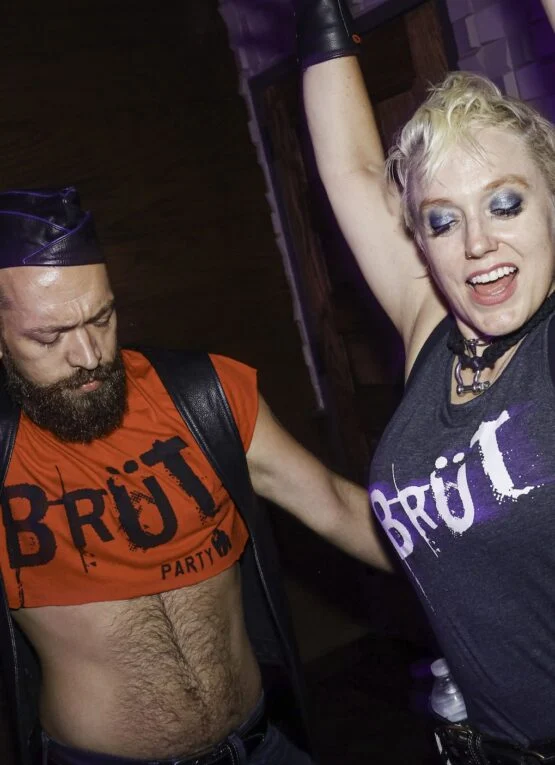The underground was born in the shadows—out of necessity, rage, desire, and survival. When the mainstream shuts its doors, the underground opens its arms. It’s where people who do not fit in anywhere else built their own world. These spaces are all about the music, the people, and a shared sense of freedom.
Underground parties are where real energy thrives—spaces where people come together. Queer, trans, straight, and all music lovers and mayhem-seekers gather for communion. Here, freedom isn’t just accepted; it’s the rule. For the LGBTQ+ community, underground parties have long been a haven for creativity and connection, forming the vibrant core of the gay underground scene. In contrast to the sanitized world of mainstream nightlife, these spaces pulse with bodies moving to raw techno and house beats until the sun comes up.

From Roots to Revolution:
Underground parties didn’t start as a trend. They began as necessity. Historically, marginalized communities needed places to come together in safety, far from the judgmental gaze of mainstream society. These were spaces where the lines between art, music, and activism blurred.
For the LGBTQ+ community, this was particularly significant. Queer people have always been at the forefront of underground culture, creating their own spaces when they weren’t welcome elsewhere. From the ballrooms of Harlem in the early 20th century to the rave scenes of the late 1980s and 1990s, there has always been an underground queer heartbeat keeping culture alive.
During the AIDS crisis of the 1980s, the underground gave queer people a place to dance through grief and celebrate life amidst mass loss. It became a way to resist invisibility, to exist loudly in a world that didn’t always want to see us. Parties were an act of defiance. The dance floor wasn’t just a place to move; it was a place to heal.
Underground: A Haven for Self-Expression:
The underground scene has always welcomed misfits, outsiders, and anyone who doesn’t feel at home in mainstream spaces. What makes it remarkable is its celebration of individuality. Different genders, sexualities, and styles all come together to form a kaleidoscope of humanity.
For queer people in particular, the underground offers a chance to break free of societal expectations. It’s a space where gender fluidity is celebrated, not questioned. A place where leather daddies, drag queens, gender non-conforming punks, and femme dancers twirl side by side under dim lights.
These parties aren’t just spaces to explore identity; they’re places to live it. No pretense. No compromise. The underground embraces messiness, creativity, and authenticity.

Underground Parties Today:
The underground isn’t dead; it’s alive and thriving, and BRÜT bringing its distinctive underground vibe to cities all across the USA. Each location offers its own unique energy and interpretation of the scene.
Los Angeles delivers a mix of gritty edge and creative flair, transforming raw, urban settings and unconventional venues into the perfect backdrop for unforgettable nights. San Francisco pulses with a bold, unapologetic spirit, channeling the city’s deep cultural roots into vibrant underground gatherings.
Chicago, known as the birthplace of house music, remains a hub for those seeking soulful, raw beats and intimate party vibes. New York, with its deep connection to queer history and underground counterculture, keeps the energy alive in high-quality, multilevel venues where techno and house beats create unforgettable experiences.
Heading south, Fort Lauderdale adds its own flavor to the leather underground, creating safe spaces where the community comes together in synergy. Out west, San Diego, Phoenix and Palm Springs host events that turn unexpected venues into immersive underground experiences.
Further north, Seattle blends its alternative spirit with darker, moodier underground aesthetics. And on the East Coast, places like Provincetown energize their communities with the magnetic pull of underground parties set against iconic backdrops.
BRÜT along to many others cities, are keeping the underground alive. For the LGBTQ+ community, they remain essential spaces that prioritize connection, freedom, and authenticity, offering a reprieve from the superficial and a chance to be unapologetically real.


The Diverse Sounds of the Underground;
Music is the heartbeat of the underground, a tapestry of styles woven together to create something electric, raw, and transformative. Each genre brings its own energy, identity, and meaning to these spaces, reflecting the spirit of rebellion, freedom, and connection that defines the underground movement. From the hypnotic rhythms of techno to the soulful grooves of house, every sound contributes to the unfiltered and unapologetic essence of underground culture.Techno:
Techno is the pulse of rebellion within these spaces. With pounding beats and stripped-down, minimalistic soundscapes, it embodies the rawness of the underground itself. Emerging in the 1980s, techno was created by artists pushing the boundaries of electronic sound. The driving rhythms create a hypnotic experience, where dancers lose themselves in the pure physicality of the music. For many, techno isn’t just an art form; it’s a call to action, a way to transcend societal norms and access true freedom.
Trance:
Thrives in the underground—pulsing, euphoric, and transportive. It builds worlds with sound, drawing dancers into a hypnotic state where time blurs and reality slips. In these raw, unfiltered spaces, trance becomes more than music—it’s a shared trip, a release, and a connection that cuts deeper than the mainstream ever could.
House:
If techno is the heartbeat, house music is the soul of the underground. Inspired by disco and rooted in queer Black and Latino communities, house music celebrates joy, resilience, and liberation. Its deep bass lines, uplifting vocals, and infectious grooves are as much about emotion as they are about movement. On an underground dance floor, house becomes our religion, reminding everyone that while rebellion is essential, so is love and celebration.
Industrial and Progressive:
For those craving something darker and edgier, industrial and progressive bring intense, visceral energy. Industrial fuses the aggression of punk with mechanical, grinding rhythms, while progressive takes complex beats from new instrumentation and channels them physicality, turning the dance floor into an arena of catharsis. These genres reject polish in favor of grit and raw emotion, reflecting the underground’s willingness to explore the shadowy corners of identity and expression.
Ambient and Experimental
Underground music also dives into realms of serenity and invention with ambient and experimental sounds. These genres provide a counterbalance to the disorder of harder beats, creating spaces for introspection and creative exploration. Whether through haunting layers of sound or avant-garde audio experiments, ambient and experimental music embody the underground’s ethos of pushing boundaries and rejecting convention.
Breakbeat and Jungle:
The energy of breakbeat and jungle brings relentless momentum. With fractured drum patterns and bass-heavy chaos, these genres keep dancers moving unpredictably. They capture the underground’s unfiltered and uncontainable spirit, each beat breaking away from conformity and forging new paths.
The Spirit of Sound:
The genres that define the underground aren’t just filler for a dance party; they’re a reflection of its essence. Techno’s raw power, Trance's otherworldliness, house’s soulful joy, industrial’s intense darkness, breakbeat’s chaotic momentum, and ambient’s introspective calm all come together to create a soundscape that is as unfiltered and unapologetic as the people who live for it.
Underground A movement:
The underground has always been more than a party. It’s been a lifeline for those who don’t fit the mold, a place where the rules don’t apply, and where you’re free to be as loud, strange, or brilliant as you dare.
Gay nightlife doesn’t thrive on clichés or conformity. It exists at the edges, in the places where authenticity rules. The underground remains vital because it reminds us that real connection isn’t about perfection. It’s about people coming together, unfiltered and raw, to create something transcendent.
Whether you find yourself in an old NYC loft pulsating with techno, a secret warehouse in Los Angeles, or a raging night club dance floor in Chicago, remember this — the underground isn’t just a place. It’s a spirit. A movement. A refusal to be anything but real.






